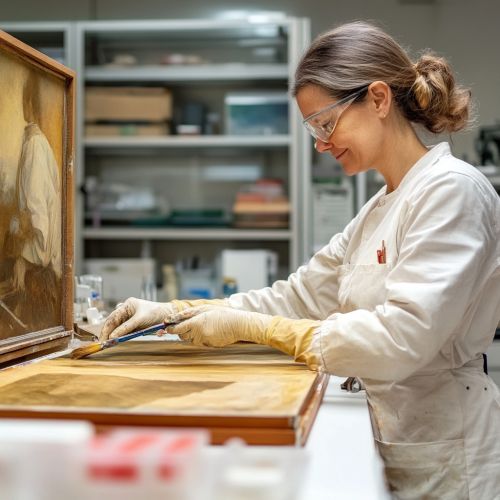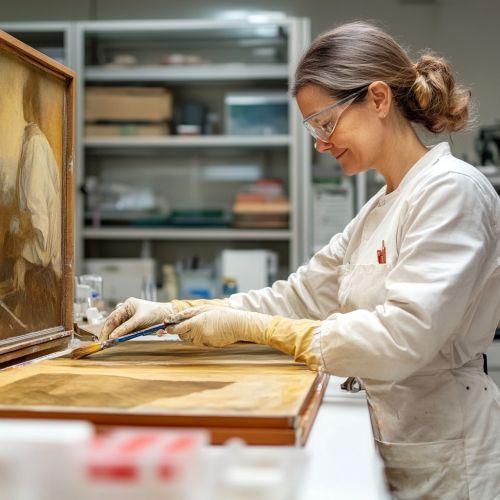Art restoration
Introduction
Art restoration refers to the process of repairing and restoring artworks to their original or near-original state. This practice is crucial for preserving cultural heritage and ensuring that future generations can appreciate historical and artistic works. Art restoration encompasses a wide range of techniques and methodologies, each tailored to the specific needs of the artwork being restored. This article delves into the history, techniques, ethical considerations, and notable examples of art restoration.
History of Art Restoration
Art restoration has a long history that dates back to ancient civilizations. Early efforts were often rudimentary and focused on maintaining the structural integrity of artworks. The Renaissance period marked a significant advancement in restoration techniques, with artists and craftsmen developing more sophisticated methods to preserve and restore artworks.
Ancient and Medieval Periods
In ancient Egypt, Greece, and Rome, basic restoration techniques were employed to maintain the appearance of sculptures and frescoes. During the medieval period, religious institutions played a significant role in the preservation of artworks, particularly illuminated manuscripts and religious icons.
Renaissance to 19th Century
The Renaissance period saw a renewed interest in classical art and the development of more advanced restoration techniques. Artists like Leonardo da Vinci and Michelangelo were known to have restored artworks. The 19th century introduced scientific methods to art restoration, with chemists and conservators working together to develop new materials and techniques.
Techniques in Art Restoration
Art restoration techniques vary depending on the type of artwork and the extent of damage. Common techniques include cleaning, consolidation, inpainting, and varnishing.
Cleaning
Cleaning is often the first step in the restoration process. It involves the removal of dirt, grime, and old varnish layers that have accumulated over time. Conservators use various solvents and cleaning agents, carefully selected to avoid damaging the artwork.
Consolidation
Consolidation is the process of stabilizing fragile or flaking paint layers. This is achieved by applying adhesives or consolidants to secure the paint to the substrate. Common consolidants include synthetic resins and natural adhesives like gelatin.
Inpainting
Inpainting involves filling in areas of lost or damaged paint to restore the visual continuity of the artwork. Conservators use reversible and stable pigments to ensure that future restorations can be performed without difficulty.
Varnishing
Varnishing is the application of a protective coating to the surface of a painting. This layer not only enhances the appearance of the artwork but also provides a barrier against environmental factors such as humidity and pollutants.


Ethical Considerations
Art restoration is guided by a set of ethical principles aimed at preserving the integrity and authenticity of the artwork. These principles include minimal intervention, reversibility, and documentation.
Minimal Intervention
Minimal intervention emphasizes the importance of preserving as much of the original material as possible. Conservators aim to make only necessary repairs, avoiding over-restoration that could alter the artwork's original appearance.
Reversibility
Reversibility is a key principle in art restoration. Techniques and materials used should be reversible, allowing future conservators to undo the restoration if needed. This ensures that the artwork can be restored again as new technologies and methods become available.
Documentation
Thorough documentation is essential in art restoration. Conservators meticulously record every step of the restoration process, including the materials and techniques used. This documentation serves as a valuable resource for future restorations and research.
Notable Examples of Art Restoration
Several high-profile art restoration projects have garnered significant attention over the years. These projects highlight the challenges and successes of art restoration.
The Sistine Chapel Ceiling
The restoration of Michelangelo's Sistine Chapel ceiling is one of the most famous restoration projects. Completed between 1980 and 1994, the project involved extensive cleaning and consolidation of the frescoes. The restoration revealed vibrant colors and intricate details that had been obscured by centuries of grime and previous restorations.
The Last Supper
Leonardo da Vinci's "The Last Supper" underwent a major restoration from 1978 to 1999. The project aimed to remove layers of overpainting and restore the original composition. The restoration was controversial, with some critics arguing that it altered the original work, while others praised the recovery of lost details.
The Ghent Altarpiece
The Ghent Altarpiece, a masterpiece by Jan van Eyck, has undergone several restorations since its completion in 1432. The most recent restoration, completed in 2020, involved advanced imaging techniques and meticulous inpainting to address previous restoration errors and reveal the original brilliance of the artwork.
Challenges in Art Restoration
Art restoration presents numerous challenges, including the identification of original materials, the selection of appropriate restoration techniques, and the management of ethical considerations.
Identification of Original Materials
Identifying the original materials used in an artwork is crucial for effective restoration. Conservators employ various analytical techniques, such as X-ray fluorescence (XRF) and infrared reflectography, to determine the composition of pigments, binders, and substrates.
Selection of Restoration Techniques
Selecting the appropriate restoration techniques requires a deep understanding of the artwork's materials and condition. Conservators must balance the need for effective restoration with the principles of minimal intervention and reversibility.
Ethical Considerations
Ethical considerations are a constant challenge in art restoration. Conservators must navigate the complexities of preserving an artwork's authenticity while making necessary repairs. This often involves difficult decisions and compromises.
Future of Art Restoration
The field of art restoration is continually evolving, with advancements in technology and materials driving new approaches to conservation.
Technological Advancements
Technological advancements, such as digital imaging and 3D printing, are revolutionizing art restoration. These technologies enable conservators to create detailed replicas of damaged areas and perform precise restorations with minimal intervention.
Sustainable Materials
The development of sustainable materials is an emerging trend in art restoration. Researchers are exploring eco-friendly alternatives to traditional restoration materials, aiming to reduce the environmental impact of conservation practices.
Interdisciplinary Collaboration
Interdisciplinary collaboration is becoming increasingly important in art restoration. Conservators, scientists, historians, and artists are working together to develop innovative solutions to complex restoration challenges.
